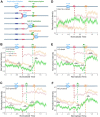Transcription-replication coordination revealed in single live cells
- PMID: 35137218
- PMCID: PMC8887460
- DOI: 10.1093/nar/gkac069
Transcription-replication coordination revealed in single live cells
Abstract
The coexistence of DNA replication and transcription during S-phase requires their tight coordination to prevent harmful conflicts. While extensive research revealed important mechanisms for minimizing these conflicts and their consequences, little is known regarding how the replication and transcription machinery are coordinated in real-time. Here, we developed a live-cell imaging approach for the real-time monitoring of replisome progression and transcription dynamics during a transcription-replication encounter. We found a wave of partial transcriptional repression ahead of the moving replication fork, which may contribute to efficient fork progression through the transcribed gene. Real-time detection of conflicts revealed their negative impact on both processes, leading to fork stalling or slowdown as well as lower transcription levels during gene replication, with different trade-offs observed in defined subpopulations of cells. Our real-time measurements of transcription-replication encounters demonstrate how these processes can proceed simultaneously while maintaining genomic stability, and how conflicts can arise when coordination is impaired.
© The Author(s) 2022. Published by Oxford University Press on behalf of Nucleic Acids Research.
Figures






Similar articles
-
Genome-wide identification of replication fork stalling/pausing sites and the interplay between RNA Pol II transcription and DNA replication progression.Genome Biol. 2024 May 21;25(1):126. doi: 10.1186/s13059-024-03278-8. Genome Biol. 2024. PMID: 38773641 Free PMC article.
-
Preventing replication stress to maintain genome stability: resolving conflicts between replication and transcription.Mol Cell. 2012 Mar 30;45(6):710-8. doi: 10.1016/j.molcel.2012.03.001. Mol Cell. 2012. PMID: 22464441 Review.
-
Replication fork stalling by bulky DNA damage: localization at active origins and checkpoint modulation.Nucleic Acids Res. 2011 Apr;39(7):2610-23. doi: 10.1093/nar/gkq1215. Epub 2010 Dec 7. Nucleic Acids Res. 2011. PMID: 21138968 Free PMC article.
-
Transcription-Replication Conflicts as a Source of Genome Instability.Annu Rev Genet. 2023 Nov 27;57:157-179. doi: 10.1146/annurev-genet-080320-031523. Epub 2023 Aug 8. Annu Rev Genet. 2023. PMID: 37552891 Free PMC article. Review.
-
RAD51 protects human cells from transcription-replication conflicts.Mol Cell. 2022 Sep 15;82(18):3366-3381.e9. doi: 10.1016/j.molcel.2022.07.010. Epub 2022 Aug 23. Mol Cell. 2022. PMID: 36002000
Cited by
-
Transcription-Replication Conflicts and Incomplete Replication as a Cause of Micronuclei-Driven Chromoanagenesis.Methods Mol Biol. 2025;2968:415-440. doi: 10.1007/978-1-0716-4750-9_25. Methods Mol Biol. 2025. PMID: 40884659
-
The minimal intrinsic stochasticity of constitutively expressed eukaryotic genes is sub-Poissonian.Sci Adv. 2023 Aug 9;9(32):eadh5138. doi: 10.1126/sciadv.adh5138. Epub 2023 Aug 9. Sci Adv. 2023. PMID: 37556551 Free PMC article.
-
Live cell imaging of DNA and RNA with fluorescent signal amplification and background reduction techniques.Front Cell Dev Biol. 2023 Jun 5;11:1216232. doi: 10.3389/fcell.2023.1216232. eCollection 2023. Front Cell Dev Biol. 2023. PMID: 37342234 Free PMC article. Review.
-
Transcription-replication conflicts drive R-loop-dependent nucleosome eviction and require DOT1L activity for transcription recovery.Nucleic Acids Res. 2025 Feb 8;53(4):gkaf109. doi: 10.1093/nar/gkaf109. Nucleic Acids Res. 2025. PMID: 39988315 Free PMC article.
-
A nucleoid-associated protein is involved in the emergence of antibiotic resistance by promoting the frequent exchange of the replicative DNA polymerase in M. smegmatis.bioRxiv [Preprint]. 2024 Jan 3:2023.06.12.544663. doi: 10.1101/2023.06.12.544663. bioRxiv. 2024. Update in: mSphere. 2024 May 29;9(5):e0012224. doi: 10.1128/msphere.00122-24. PMID: 38260554 Free PMC article. Updated. Preprint.
References
Publication types
MeSH terms
LinkOut - more resources
Full Text Sources

